Today’s Current Affairs: 15th May 2025 for UPSC IAS exams, State PSC exams, SSC CGL, State SSC, RRB, Railways, Banking Exam & IBPS, etc
Table of Contents
Madku Island:

The Chhattisgarh High Court is actively monitoring the development initiatives at Madku Dweep, a place of significant local importance.
- Madku Island is situated on the banks of the Shivnath River (longest tributary of the Mahanadi River), in the Bilaspur district of Chhattisgarh.
- The name Madku stems from the fact that the island is in the shape of a frog.
- It has an area of around 24 hectares.
- Madku Island is popularly known as Kedar Tirth and Harihar Kshetra Kedar Dweep.
- Archaeologists have discovered prehistoric stone tools, epigraphs, and coins on this island.
- Stone inscriptions have also been found, which are believed to date back to the 3rd century BC.]
- One stone inscription was in Brahmi script and another in Shankha script.
- Madku Dweep is also home to several ancient and unique idols of Lord Shiva, Ganesha, Shiv-Parvati, Nandi, and various other Gods.
- Archaeologists have successfully excavated 19 temples on Madku Dweep.
- Eighteen of these temples face east, whereas the middle temple is the only one that faces west.
- The architectural style of these temples, along with the sculptures and idols, is believed to be similar to that of the Great Kalchuris.
- Madku Island is also the place where an annual and important Christian fair has been hosted since 1909.
- The fair is organized in February, it is attended by Christians all across the Chhattisgarh state and beyond, and is locally known as Masihi Mela.
Shakargarh Bulge:

The Shakargarh Bulge was one of the places where a major build-up of tanks and armoured vehicles by the Pakistan army was spotted recently.
- The Shakargarh Bulge is an important area in Pakistani territory that sticks out into India, bordered by the Ravi and Chenab rivers.
- Its geography consists of flat terrain and proximity to key road and rail networks, making it a strategic corridor for both sides.
- The area’s flat terrain and its proximity to Indian cities such as Amritsar, Pathankot, Batala, and Gurdaspur, as well as road links to Jammu, makes it a high-priority area for the Indian Army.
- This area was the site of the notable Battle of Basantar during the 1971 Indo-Pakistan War.
- It was a 12-day engagement that shaped the outcome of the western front in the 1971 war.
Agamic temples:
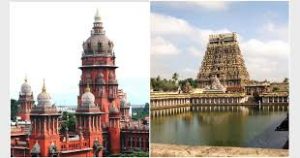
The Supreme Court recently requested a committee formed by the Madras High Court to identify Agamic temples as against non-Agamic temples in Tamil Nadu in three months.
- The Agamas are a collection of scriptures of Hindu devotional schools.
- The term literally means tradition or “that which has come down”, and the Agama texts describe cosmology, epistemology, philosophical doctrines, precepts on meditation and practices, four kinds of yoga, mantras, temple construction, deity worship, and ways to attain sixfold desires.
- The origin and chronology of Agamas is unclear.
- The 3 main branches of Agama texts are Shaivism (of Lord Shiva), Vaishnavism (of Lord Vishnu), and Shaktism (of Adi Shakti).
- The Agamic traditions are sometimes called Tantrism, although the term “Tantra” is usually used specifically to refer to Shakta Agamas.
- The Agamas do not derive their authority from the Vedas, but are not antagonistic to them.
- They are all Vedic in spirit and character.
- That is the reason why they are regarded as authoritative.
- Many South Indian temples, especially in Tamil Nadu, follow Agamic traditions for daily rituals and festivals.
Adyar River:
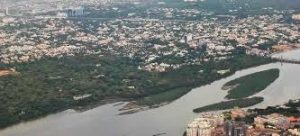
A Rs 1,500-crore project to rejuvenate and restore a ‘dead’ 44-km stretch of River Adyar is stuck since 2023 and lying choked in the city.
- The Adyar, originating near the Chembarambakkam Lake in Kanchipuram district, is one of the three rivers which winds through Chennai, Tamil Nadu, and joins the Bay of Bengal at the Adyar Estuary.
- The estuary, covering an area of about 300 acres, was made a protected wildlife reserve in 1987.
- The 42.5-kilometre (26.4 mi) long river contributes to the estuarine ecosystem of Chennai.
- The river forms a backwater near the mouth, known as the Adyar Creek, due to the formation of sandbars at the mouth.
- This creek is a natural channel which carries tidal water back into the sea.
- The river collects surplus water from about 200 tanks and lakes, small streams, and the rainwater drains in the Chennai city, with a combined catchment area of 860 sq.km.
- Most of the waste from the city is drained into this river.
Desalination Technology:
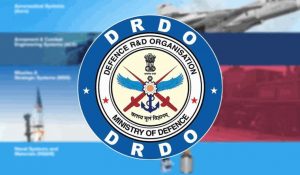
The Defence Research & Development Organisation (DRDO) has developed an indigenous high-pressure nanoporous multilayered polymeric membrane for seawater desalination.
- The project was executed by Defence Materials Stores Research & Development Establishment (DMSRDE), Kanpur, under the Aatmanirbhar Bharat
- The membrane was designed to meet the operational needs of the Indian Coast Guard (ICG), particularly to withstand chloride ion-induced instability in saline water.
- The technology is intended for use in Offshore Patrol Vessels (OPVs) of the Coast Guard, providing self-reliant onboard freshwater capability.
- Desalination is the removal of dissolved salts and minerals from saline or brackish water to make it fit for human use.
- Two primary technologies used globally:
- Reverse Osmosis (RO) – pressure-driven membrane-based filtration.
- Thermal Desalination – evaporation-condensation method using heat.
- A desalination plant converts seawater into freshwater by removing salts to meet drinking or industrial quality standards.
Working of Reverse Osmosis (RO) Desalination:
- Osmosis refers to the natural movement of water from an area of low solute concentration to high solute concentration through a semi-permeable membrane.
- In reverse osmosis, external pressure is applied to push water from a high-solute (saline) side to a low-solute (freshwater) side, against the natural osmotic gradient.
- Microscopic pores in the RO membrane allow water molecules to pass while blocking salts and other impurities.
- Seawater typically has a TDS (Total Dissolved Solids) of ~35,000 ppm, while RO brings it down to 200–500 ppm, making it potable.
Golden Dragon 2025:
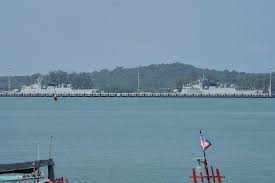
Cambodia and China have launched their largest-ever Golden Dragon joint military exercise involving land, sea, and air operations.
- The Golden Dragon military exercise is a bilateral annual drill between China and Cambodia, first initiated in late 2016 to strengthen military cooperation and strategic ties.
- The official theme of Golden Dragon 2025 is joint counter-terrorism operations and humanitarian relief, portraying the exercise as a peace-building and capacity-building initiative.
- The 2025 edition is being held at the Ream Naval Base, located in Sihanoukville, on Cambodia’s southern coast.
- The base was officially inaugurated in April 2025 with the docking of Chinese warships, highlighting China’s expanding naval presence in the Gulf of Thailand.The Golden Dragon drills coincide with the S. -Philippines-led ‘Balikatan’ exercise involving troops from the U.S, Philippines, Australia, and Japan.
- China’s access to dual-use ports in countries like Cambodia echoes similar concerns in places such as Sri Lanka (Hambantota) and Pakistan (Gwadar).
- The exercise reflects China’s growing ability to project military power beyond its immediate borders, consistent with its “String of Pearls” strategy.
Colombia formally joined China’s Belt and Road Initiative:
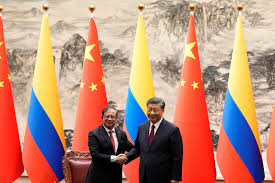
Colombia formally joined China’s Belt and Road Initiative (BRI) during a high-level meeting of Latin American leaders in Beijing.
- Colombia is known as the “Gateway of South America”, strategically located in the northwest, connecting South America with Central and North America.
- It shares land boundaries with Venezuela, Brazil, Panama, Peru, and Ecuador, and maritime boundaries with the Caribbean Sea and the Pacific Ocean.
- Colombia is rich in natural resources like petroleum, natural gas, coal, and gold, which makes it a valuable partner for foreign investment and energy cooperation.
- The country consists of two main regions: the Andes Mountains and broad lowland plains.
Tsarap Chu Conservation Reserve:
Himachal Pradesh notified Tsarap Chu Conservation Reserve, India’s largest protected area (1,585 sq km), to safeguard high-altitude biodiversity, particularly snow leopards, and strengthen wildlife corridors.A protected area in Spiti Valley, Himachal Pradesh, notified under Section 36A (1) of the Wildlife (Protection) Act, 1972.
Aims to conserve snow leopards, rare Himalayan fauna, and critical wildlife corridors.
Jute Corporation of India (JCI):
The Jute Corporation of India (JCI) raised the Minimum Support Price (MSP) for raw jute from ₹5,335 to ₹5,650 per quintal for the 2025–26 crop year to curb distress selling by farmers.JCI is a government-owned price support agency tasked with procuring raw jute at MSP from farmers to ensure fair prices and prevent exploitation. Headquarters: Kolkata, West Bengal. Established in: 1971 under Companies Act, 1956. Parent Ministry: Ministry of Textiles, Government of India. Organisational Structure: Operates through Departmental Purchase Centres (DPCs) and cooperatives.
Territorial Army:
The Ministry of Defence has empowered the Army Chief under Rule 33 of the Territorial Army Act, 1948, to fully mobilise the Territorial Army (TA) amid heightened tensions with Pakistan. Territorial Army Act, 1948; formally launched on October 9, 1949.
Controlling Ministry: Ministry of Defence, Government of India. Governed by Territorial Army Act, 1948 – Rule 33 permits full mobilisation during national exigencies. A volunteer reserve force comprising part-time “citizen soldiers” from civilian backgrounds (businessmen, professionals). Aims to relieve the regular Army from non-combat duties and augment its manpower during conflict or crisis.
Extended Fund Facility (EFF):
The IMF Executive Board approved an immediate disbursement of $1 billion to Pakistan under the Extended Fund Facility (EFF).EFF is an IMF lending mechanism designed to help countries facing prolonged balance of payments problems due to deep structural economic weaknesses.Governed by: International Monetary Fund (IMF), part of Bretton Woods institutions.
Loan Type: Repayable loan, not a grant or financial aid. Tenure: Extended period (3+ years), with longer repayment timelines than standard IMF loans. Purpose: Facilitates medium-term structural reforms — e.g., improving tax systems, reducing inflation, curbing unsustainable fiscal deficits. Disbursement: Tranches released based on periodic reviews of policy implementation by the borrowing country.
Zero-Emission Trucking:
Principal Scientific Adviser to the Government of India, released a report on India’s Priority Corridors for Zero-Emission Trucking.Zero-Emission Trucking (ZET) refers to freight transportation using battery electric or hydrogen fuel cell trucks that emit no tailpipe emissions, unlike traditional diesel vehicles.




